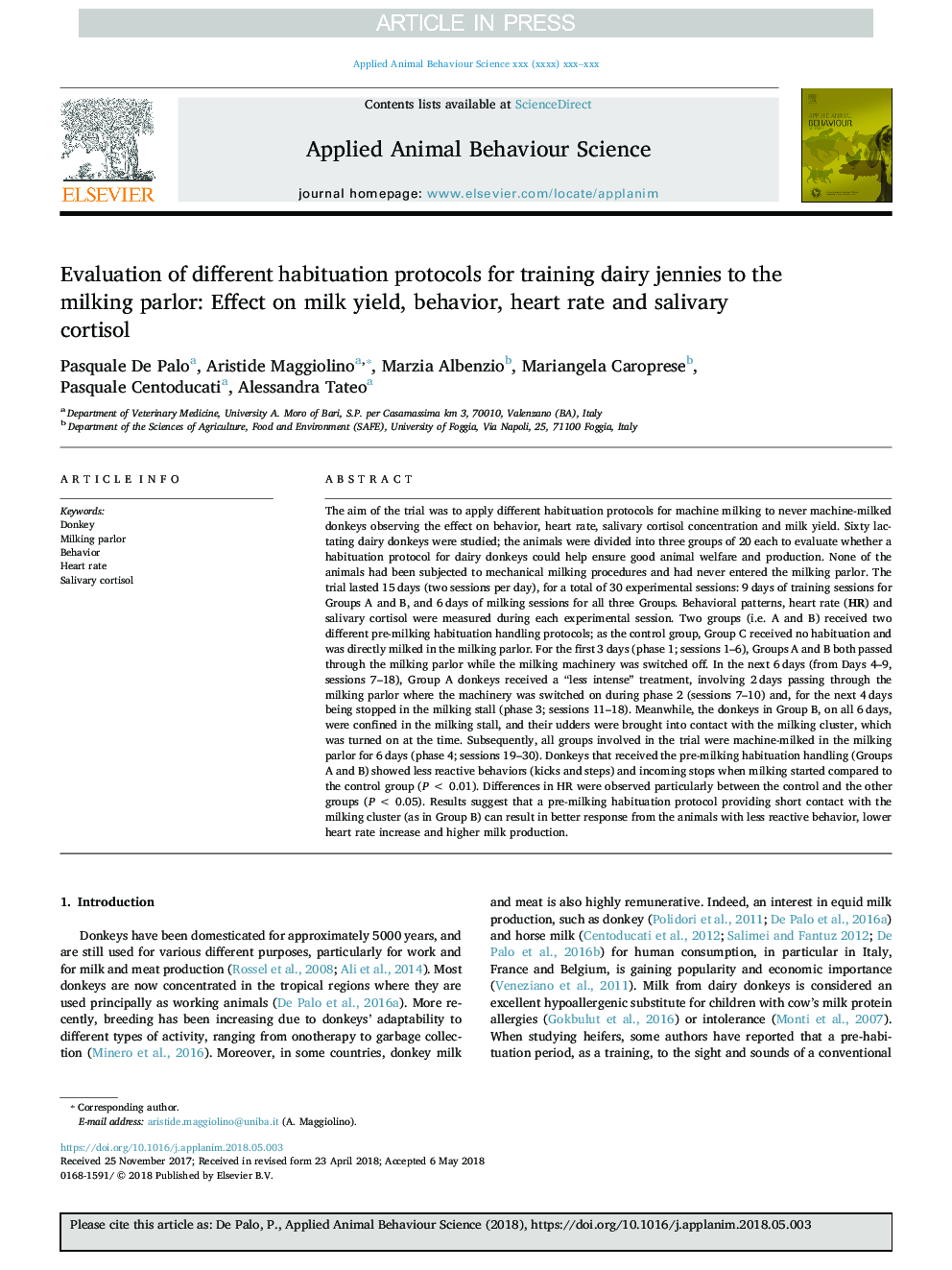| کد مقاله | کد نشریه | سال انتشار | مقاله انگلیسی | نسخه تمام متن |
|---|---|---|---|---|
| 8882756 | 1625302 | 2018 | 9 صفحه PDF | دانلود رایگان |
عنوان انگلیسی مقاله ISI
Evaluation of different habituation protocols for training dairy jennies to the milking parlor: Effect on milk yield, behavior, heart rate and salivary cortisol
ترجمه فارسی عنوان
ارزیابی پروتکل های مختلف عادت برای آموزش مرغ های شیری به اتاق شیرخواری: تاثیر بر عملکرد شیر، رفتار، ضربان قلب و کورتیزول
دانلود مقاله + سفارش ترجمه
دانلود مقاله ISI انگلیسی
رایگان برای ایرانیان
کلمات کلیدی
خر شیردوشی، رفتار - اخلاق، ضربان قلب، کورتیزول بزاق،
موضوعات مرتبط
علوم زیستی و بیوفناوری
علوم کشاورزی و بیولوژیک
علوم دامی و جانورشناسی
چکیده انگلیسی
The aim of the trial was to apply different habituation protocols for machine milking to never machine-milked donkeys observing the effect on behavior, heart rate, salivary cortisol concentration and milk yield. Sixty lactating dairy donkeys were studied; the animals were divided into three groups of 20 each to evaluate whether a habituation protocol for dairy donkeys could help ensure good animal welfare and production. None of the animals had been subjected to mechanical milking procedures and had never entered the milking parlor. The trial lasted 15â¯days (two sessions per day), for a total of 30 experimental sessions: 9â¯days of training sessions for Groups A and B, and 6â¯days of milking sessions for all three Groups. Behavioral patterns, heart rate (HR) and salivary cortisol were measured during each experimental session. Two groups (i.e. A and B) received two different pre-milking habituation handling protocols; as the control group, Group C received no habituation and was directly milked in the milking parlor. For the first 3â¯days (phase 1; sessions 1-6), Groups A and B both passed through the milking parlor while the milking machinery was switched off. In the next 6â¯days (from Days 4-9, sessions 7-18), Group A donkeys received a “less intense” treatment, involving 2â¯days passing through the milking parlor where the machinery was switched on during phase 2 (sessions 7-10) and, for the next 4â¯days being stopped in the milking stall (phase 3; sessions 11-18). Meanwhile, the donkeys in Group B, on all 6â¯days, were confined in the milking stall, and their udders were brought into contact with the milking cluster, which was turned on at the time. Subsequently, all groups involved in the trial were machine-milked in the milking parlor for 6â¯days (phase 4; sessions 19-30). Donkeys that received the pre-milking habituation handling (Groups A and B) showed less reactive behaviors (kicks and steps) and incoming stops when milking started compared to the control group (Pâ¯<â¯0.01). Differences in HR were observed particularly between the control and the other groups (Pâ¯<â¯0.05). Results suggest that a pre-milking habituation protocol providing short contact with the milking cluster (as in Group B) can result in better response from the animals with less reactive behavior, lower heart rate increase and higher milk production.
ناشر
Database: Elsevier - ScienceDirect (ساینس دایرکت)
Journal: Applied Animal Behaviour Science - Volume 204, July 2018, Pages 72-80
Journal: Applied Animal Behaviour Science - Volume 204, July 2018, Pages 72-80
نویسندگان
Pasquale De Palo, Aristide Maggiolino, Marzia Albenzio, Mariangela Caroprese, Pasquale Centoducati, Alessandra Tateo,
